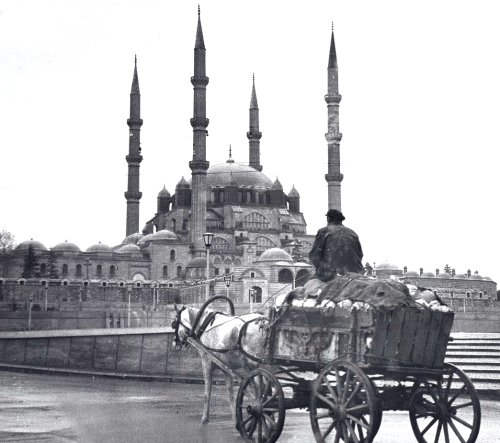Mosque
Today, we build a mosque. The University of Houston's College of Engineering presents this series about the machines that make our civilization run, and the people whose ingenuity created them.
 David Macaulay has delighted us with books on the great engineering works of the past. With titles like: Castle, Mill, Cathedral, Ship, Underground, Pyramid, they've led us through various great constructions. And now I have his latest book, Mosque.
David Macaulay has delighted us with books on the great engineering works of the past. With titles like: Castle, Mill, Cathedral, Ship, Underground, Pyramid, they've led us through various great constructions. And now I have his latest book, Mosque.
Macaulay shows us how yet another fictitious, but representative, structure was built. This time we're back in the Ottoman Empire of the mid 1500s, in Istanbul. It's been a century since the Moslems conquered Constantinople and renamed it.
Perhaps the most beautiful of the Ottoman mosques is the one at Edirne, about 130 miles west of Istanbul. It was done by the great Turkish architect Mimar Sinan, during this period. Macaulay bases his fictional mosque upon Sinan's work.
By this time, Gothic cathedrals had seen their day. They, and the great Christian churches that followed them, were all laid out in the shape of a cross, pointing eastward. The focus of that design is the chancel at the east branch of the cross, with the congregation occupying the other three branches.
A mosque has its own unique shape, equally well-defined. Ideally it's a large open cubical prayer space with a high domed roof. The front side faces Mecca, and on its inside wall is a niche called a mihrab -- a symbolic gateway to paradise. A mosque also has as least one minaret -- a tall tower for calling the faithful to prayer. That mosque at Edirne has four lovely minarets, twice as tall the mosque itself. A courtyard on the side away from Mecca provides fountains for worshipers to wash, before they enter.
All this creates its own set of design problems. The Gothic cathedral used flying buttresses to hold a high ceiling in place over a large open space. To stabilize a mosque from the sides, smaller semi-domes surround the large central dome.
Cathedrals usually had one or two spires to serve the same visual function as minarets -- to signal its presence from miles away. Instead of a cross on the spire, the mosque's dome is topped with an upward-reaching bronze crescent.
While cathedrals display human images, the décor in a mosque is far more abstract. Instead of pictures in stained glass, air and light are admitted through lacy stonework filigree in the lower windows. We find floral designs and highly stylized Arab calligraphy with passages from the Koran, all patterned into complex geometrical forms. Much of the design is pure geometry alone.
Enter one of these great mosques and, as in a cathedral, we feel ourselves in a place apart. We are, for a moment, beyond the rough-and-tumble, problem-drenched world outside.
We catch that in Macaulay's book. It seems to be about an unfamiliar place, yet it leaves us feeling quite at home. It causes me to recall every time I've entered one of the great mosques or cathedrals -- interior beauty enveloping me in precisely the same contradictory mix of awe, along with peace and repose.
I'm John Lienhard, at the University of Houston, where we're interested in the way inventive minds work.
(Theme music)
D. Macaulay, Mosque. Boston. MA, Houghton Mifflin Co. 2003.
A listener adds an interesting note to this program: Another important function of the minarets is cooling. They act as chimneys in which hot air entering the mosque is drawn up and escapes out the top. As long as the resulting breeze at floor level is below body temperature, it cools the worshipers both by evaporating persperation and by direct convection.

Sinan's great mosque at Edirne.
(photo by John Lienhard, Nov. 1974)